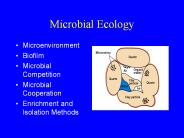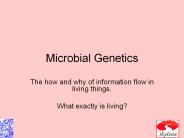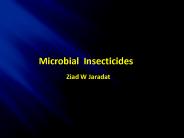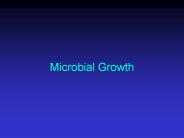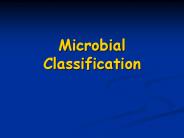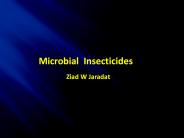Microbial PowerPoint PPT Presentations
All Time
Recommended
Microbial inoculants, such as biofertilizers, leverage beneficial microorganisms to enhance plant growth and soil fertility. Earth Microbial specializes in developing and utilizing these powerful tools, promoting sustainable agriculture by improving nutrient availability, disease resistance, and overall plant health while minimizing the need for chemical inputs.
| PowerPoint PPT presentation | free to download
Microbial Ecology and Controlling Microbial Growth Module 5
| PowerPoint PPT presentation | free to view
MICROBIAL BIOTECHNOLOGY Microbial Biotechnology in the Environment A. Bioremediation - uses microorganisms to degrade waste materials into less toxic or non-toxic ...
| PowerPoint PPT presentation | free to view
Microbial physiology ... release energy Energy Production 3 Biochemical Mechanisms Utilized ... DNA DNase Proteins Protease removes a Hydrogen ...
| PowerPoint PPT presentation | free to download
II. Environmental effects on microbial growth I. Microbial growth A. Exponential growth and how to calculate it B. Growth curve of bacteria in culture C. Measuring ...
| PowerPoint PPT presentation | free to view
Spatial and temporal variability in microbial mat communities from pre and posteruption Loihi Volcan
| PowerPoint PPT presentation | free to download
Earth Microbial offers the finest microbial inoculants for turf grass and agriculture. Their products provide beneficial microorganisms that enhance soil health, nutrient uptake, and plant growth. With a focus on quality and effectiveness, Earth Microbial ensures optimal results for turf grass and agricultural applications.
Microbial Ecology Microbial Ecology the interactions of m.o. with the biotic and abiotic components of the environment The importance of these interactions and their ...
| PowerPoint PPT presentation | free to download
Microbial Genetics
| PowerPoint PPT presentation | free to view
Microbial Hazards
| PowerPoint PPT presentation | free to download
Title: Microbial Genetics Author: SMCCCD Last modified by: Nickolas V. Kapp Created Date: 3/25/2003 1:38:47 PM Document presentation format: On-screen Show (4:3)
| PowerPoint PPT presentation | free to download
Title: Control of microbial growth Author: SMCCCD Last modified by: Nick Kapp Created Date: 2/26/2003 9:30:05 PM Document presentation format: On-screen Show
| PowerPoint PPT presentation | free to download
Microbial Ecology Microenvironment Biofilm Microbial Competition Microbial Cooperation Enrichment and Isolation Methods Winogradsky Column Viable Stain AODC ...
| PowerPoint PPT presentation | free to download
Microbial Genetics The how and why of information flow in living things. What exactly is living ...
| PowerPoint PPT presentation | free to download
Title: Microbial Metabolism Author: str0807 Last modified by: tiptap Created Date: 9/14/1999 6:21:26 PM Document presentation format: On-screen Show (4:3)
| PowerPoint PPT presentation | free to download
Chapter 6 Microbial Growth What are Populations Colonies What are Populations Colonies Deep-freezing: -50 to -95 C Lyophilization (freeze-drying): Frozen (-54 to ...
| PowerPoint PPT presentation | free to download
Microbial Evolution Ecology and Evolution are inextricably connected Ecology = the study of interactions between organisms and their environment (physical, chemical ...
| PowerPoint PPT presentation | free to download
Chapter 5 Microbial Biotechnology The rich abundance of bacteria and other microbes provides a wealth of potential biotech applications. * Before you can consider the ...
| PowerPoint PPT presentation | free to download
Microbial Nutrition & Growth Nutrient Requirements Nutrient Transport Processes Culture Media Growth in Batch Culture Mean Generation Time and Growth Rate
| PowerPoint PPT presentation | free to download
Microbial Communities & Feeding Specialization of Insects at The Sevilleta LTER Dan Colman Focal Organism Epicauta longicollis Member of Meloidae family 18-25 mm ...
| PowerPoint PPT presentation | free to view
Microbial Hazards
| PowerPoint PPT presentation | free to view
Microbial Genetics Mutation Genetic Recombination Model organism E. coli Molecular Cloning Bioinformatics Golden Rice Genetic Word List 4 Transduction ...
| PowerPoint PPT presentation | free to download
Chapter 5 Microbial Biotechnology The gene for one protein of interest is cloned and expressed as a fusion protein attached to the DNA-binding domain (DBD) of another ...
| PowerPoint PPT presentation | free to download
Microbial Nutrition Nutrition process by which chemical substances (nutrients) are acquired from the environment and used in cellular activities
| PowerPoint PPT presentation | free to view
Microbial Physiology
| PowerPoint PPT presentation | free to view
Microbial Growth Chapter 6 Microbial Growth - refers to the # of cells, not the size of the cells Requirements for Growth Physical Chemical Physical Requirements ...
| PowerPoint PPT presentation | free to view
Microbial Insecticides Ziad W Jaradat The gene for the juvenile estrase was purified from the insect Heliothis virescens ( tobacco budworm) and the coding sequence ...
| PowerPoint PPT presentation | free to download
Microbial Anatomy Structural vs Functional Comparisons Eucaryotic Cells Procaryotic Cells The Eucaryotic Cell The Procaryotic Cell Comparative Functional Anatomy ...
| PowerPoint PPT presentation | free to view
Microbial growth Typically refers to an increase in population rather than in size Influence of environmental factors on growth Quorum sensing Bacteria can ...
| PowerPoint PPT presentation | free to view
Microbial Nutrition ... Carbon Hydrogen Oxygen Phosphorous Sulfur Nitrogen * * Classification Based on Sources of Essential Nutrients Carbon sources Heterotroph ...
| PowerPoint PPT presentation | free to view
Microbial Growth * * * * * * * * * * * * * * * * * * * * * * * * * * * * Growth of Microbes Increase in number of cells, not cell size One cell becomes colony of ...
| PowerPoint PPT presentation | free to download
Microbial Enzymes Used in applications from food production to molecular biology research Microbial enzymes are active in a pH range of 3.0 - 9.0, whereas animal ...
| PowerPoint PPT presentation | free to download
CHAPTER 15 Microbial Genomics Genomic Cloning Techniques Vectors for Genomic Cloning and Sequencing MS2, RNA virus- 3569 nt sequenced in 1976 X17, ssDNA virus 5386 nt ...
| PowerPoint PPT presentation | free to view
Microbial Ecology 138023 Oded Beja Introduction Syllabus presentation What is microbial diversity? A two-credit course with one hour of lecture and one hour ...
| PowerPoint PPT presentation | free to view
Microbial Nutrition Gary Andersen Reference Chapter 2,5,6, 7, 8, 9 Microbiology by Tortora, Funke & Case Metabolism Chemical Substances Cell Growth
| PowerPoint PPT presentation | free to view
Microbial Metabolism Biochemical diversity Metabolism Relationships Metabolism Pathways Metabolism Define Requirements Energy Enzymes Rate Limiting step Reaction time ...
| PowerPoint PPT presentation | free to view
I. The Common Nutrient Requirements of Microbial Cells 95% of dry weight of bacterial cells is made up of 10 major components g/l used for carbohydrates ...
| PowerPoint PPT presentation | free to view
Microbial Fuel Cells And You! * * * * * * * * * * * What are MFCs? MFCs are bioelectrical devices that harness the natural metabolisms of microbes to produce ...
| PowerPoint PPT presentation | free to download
Microbial Metabolism Ch 5 Metabolism is the sum of the chemical reactions in an organism. Catabolism is the energy-releasing processes. Anabolism is the energy-using ...
| PowerPoint PPT presentation | free to view
Microbial Genetics What is the genetic material? DNA Nucleotide base pairs A-T, ... Virus transfer DNA general vs. specialized animation What is transformation?
| PowerPoint PPT presentation | free to view
Chapter 5 Microbial Biotechnology Interesting Facts Microbes have existed on the earth for over 3.5 billion years 50% of the living matter is comprised of ...
| PowerPoint PPT presentation | free to view
Microbial Genomes. 1) Methods for Studying Microbial Genomes ... Bioinformatics. Databases. Literature. Sequence. Experimental. Genome Annotation ...
| PowerPoint PPT presentation | free to view
Microbial Ecology Presented by: FARASAT ALI NOMAN RASHID The importance of these interactions and their effects on the environment Biogeochemical Cycles : describe ...
| PowerPoint PPT presentation | free to view
Microbial Growth The Growth Curve. Counting chambers ... Temperature. Psychrophiles: (0-20oC) Alga Chlamydomonas nivalis snow algae. Thermus aquaticus ...
| PowerPoint PPT presentation | free to view
Chapter 6 Microbial Ecology Dilution Plates 1 ml 1 ml 1 ml 1 ml 1 ml 1 ml 10-1 10-2 10-3 10-4 10-5 10-6 Statistically relevant colony density: 30 - 300 Technique ...
| PowerPoint PPT presentation | free to view
Molecular Microbial Ecology
| PowerPoint PPT presentation | free to view
Chapter 6 Microbial Growth Bacterial Cell Division New cells are formed by cell fission Cells do not grow they double their cytoplasmic contents and membrane They ...
| PowerPoint PPT presentation | free to view
This presented indicates that how microbial organism are communication from one cells to another cells.
| PowerPoint PPT presentation | free to download
Chapter 6. Microbial Growth. Microbial growth is the increase in number of ... Lyophilization (freeze-drying): Frozen ( 54 to 72 C) and dehydrated in a vacuum ...
| PowerPoint PPT presentation | free to view
Microbial Classification The Prokaryotes: Domains Bacteria and Archaea One circular chromosome, not in a membrane No histones No organelles Peptidoglycan cell walls ...
| PowerPoint PPT presentation | free to download
Microbial Biogeochemistry. Chemical reactions occurring in the environment ... Transport Limitations; Advection-Diffusion. Transport by advection and diffusion: ...
| PowerPoint PPT presentation | free to view
... medium for dispersing many types of microbes to new environment many microbial diseases are transmitted through the air ... Siklus Karbon Fiksasi ...
| PowerPoint PPT presentation | free to view
Microbial Genetics Dr. Gary Andersen, 913-279-2211 Some s used with permission from Curtis Smith, KCKCC Reference: Chapter 7,8 from (Black, J., 2005)
| PowerPoint PPT presentation | free to view
Microbial Insecticides Ziad W Jaradat The gene for the juvenile estrase was purified from the insect Heliothis virescens ( tobacco budworm) and the coding sequence ...
| PowerPoint PPT presentation | free to download
Microbial Metabolism Enzymes * * * * * * * * * * Oxidative phosphorylation Electrons are transferred from organic compounds through a series of electron carriers to ...
| PowerPoint PPT presentation | free to view
MICROBIAL CONTROL.. The History and Concept of Microbial Control. ... Physiological State Of The Microbe. Environment. Actions Of Microbial Control Agents. ...
| PowerPoint PPT presentation | free to view













